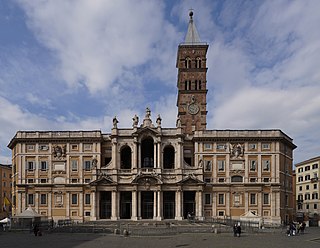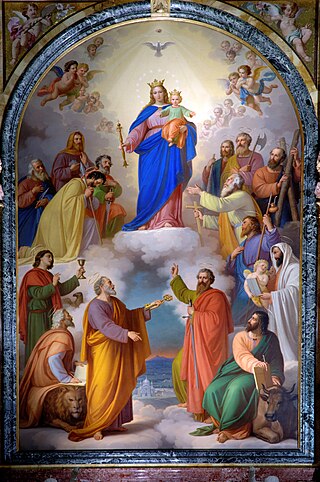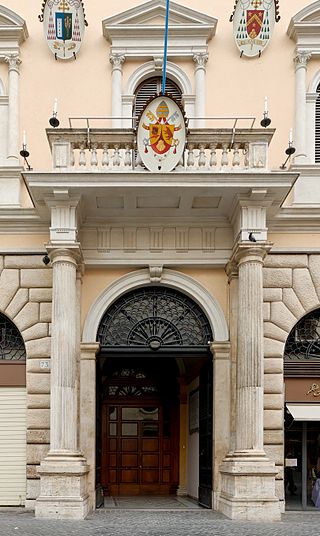
The Basilica of Saint Mary Major, or church of Santa Maria Maggiore, is one of the four Major papal basilicas as well as one of the Seven Pilgrim Churches of Rome and the largest Marian church in Rome, Italy.

Our Lady of China, the Great Mother, also known as Our Lady of Donglü, is a Roman Catholic title of the Blessed Virgin Mary associated with a reputed Marian apparition in Donglü, China in 1900.

The Basilica della Santa Casa is a Marian shrine in Loreto, in the Marches, Italy. The basilica is known for enshrining the house in which the Blessed Virgin Mary is believed by some Catholics to have lived. Pious legends claim the same house was flown over by angelic beings from Nazareth to Tersatto, then to Recanati, before arriving at the current site.

Salus Populi Romani is a Catholic title associated with the venerated image of the Blessed Virgin Mary in Rome. This Byzantine icon of the Madonna and Child Jesus holding a Gospel book on a gold ground, now heavily overpainted, is kept in the Borghese (Pauline) Chapel of the Basilica of Saint Mary Major. Pope Francis has constructed a burial vault near the icon, intended to be his final resting place.

Our Lady of Aparecida, is a title of the Blessed Virgin Mary associated with the Immaculate Conception.

The Basilica of Holy Mary, the Help of Christians also known as the National Shrine of Our Mother of Sheshan is a Roman Catholic Marian shrine in Shanghai, China. Its name comes from the locality of Sheshan Hill in Songjiang District, to the west of Shanghai's metropolitan area.

A canonical coronation is a pious institutional act of the pope, duly expressed in a formal decree of a papal bull, in which the pope bestows the pontifical right to impose an ornamental crown, a diadem or an aureole to an image of Christ, Mary or Joseph that is widely venerated in a particular diocese or locality. The act was later regulated to Marian images only, through the De coronatione imaginum B.V. Mariae that was issued on 25 March 1973.

Mary, the mother of Jesus in Christianity, is known by many different titles, epithets, invocations, and several names associated with places.
The Pontifical Roman Major Seminary is the major seminary of the Diocese of Rome. It is located at the Archbasilica of Saint John Lateran. Since 2017, the rector of the seminary has been Gabriele Faraghini, a priest of the Little Brothers of Jesus Caritas.

The history of Catholic Mariology traces theological developments and views regarding Mary from the early Church to the 21st century. Mariology is a mainly Catholic ecclesiological study within theology, which centers on the relation of Mary, the Mother of God, and the Church. Theologically, it not only deals with her life but with her veneration in life and prayer, in art, music, and architecture, from ancient Christianity to modern times.

The Mariology of the popes is the theological study of the influence that the popes have had on the development, formulation and transformation of the Roman Catholic Church's doctrines and devotions relating to the Blessed Virgin Mary.

The veneration of Mary in the Catholic Church encompasses various devotions which include prayer, pious acts, visual arts, poetry, and music devoted to her. Popes have encouraged it, while also taking steps to reform some manifestations of it. The Holy See has insisted on the importance of distinguishing "true from false devotion, and authentic doctrine from its deformations by excess or defect". There are significantly more titles, feasts, and venerative Marian practices among Roman Catholics than in other Western Christian traditions. The term hyperdulia indicates the special veneration due to Mary, greater than the ordinary dulia for other saints, but utterly unlike the latria due only to God.

Mary, the Help of Christians is a Catholic title of the Blessed Virgin Mary, based on a devotion now associated with a feast day of the General Roman Calendar on 24 May.

The Roman Colleges, also referred to as the Pontifical Colleges in Rome, are institutions established and maintained in Rome for the education of future ecclesiastics of the Catholic Church. Traditionally many were for students of a particular nationality. The colleges are halls of residence in which the students follow the usual seminary exercises of piety, study in private, and review the subjects treated in class. In some colleges there are special courses of instruction but the regular courses in philosophy and theology are given in a few large central institutions, such as Pontifical Urbaniana University, the Pontifical Gregorian University, the Pontifical Lateran University, and the Pontifical University of Saint Thomas Aquinas, Angelicum.

Catholic Marian churches are religious buildings dedicated to the veneration of the Blessed Virgin Mary. These churches were built throughout the history of the Catholic Church, and today they can be found on every continent including Antarctica. The history of Marian church architecture tells the unfolding story of the development of Catholic Mariology.
Our Lady of Charity is a celebrated Marian title of the Blessed Virgin Mary venerated in many Catholic countries.

Our Mother of Sheshan or Our Lady of Sheshan (佘山聖母), also known as Our Mother of Zo-sè, is a celebrated Marian title of the Blessed Virgin Mary venerated by Chinese Roman Catholics. Among its religious devotees, the statue is sometimes known as Our Lady of Luck or Our Lady of Good Luck due to the Chinese symbology of "Fu" (福) associated with the styling posture of the entire image. The original image is currently enshrined in the National Shrine and Minor Basilica of Our Lady of Sheshan, in Shanghai, China.

Grotta di Lourdes is an artificial cave in the Vatican gardens. It was built in 1902–05 and is a replica of the Lourdes Grotto in France. The context of building this grotto is the vision of the Madonna that a young girl, Bernadette Soubirous, experienced 18 times. Prior to that the Pope had promulgated the dogma of the Immaculate Conception in 1854.

Our Lady of Arabia is a Catholic title of the Blessed Virgin Mary holding a Rosary and the Child Jesus, as venerated in Kuwait and Bahrain by its faithful devotees. Under this venerated Marian title, she is designated as the patroness of the Apostolic Vicariates of Northern and Southern Arabia.

Our Lady of Consolation or Mary, Comforter of the Afflicted is a title of the Blessed Virgin Mary venerated in the Catholic Church.
















